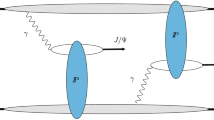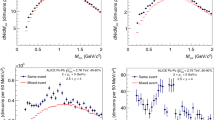Abstract
We study the effect of nuclear matter in ϒ production in dAu collisions at RHIC and pPb collisions at the LHC. We find that the nuclear modification factor, \(R^{\varUpsilon}_{d\mathrm{Au}}\), measured at RHIC is not satisfactorily reproduced by the conventional effects used in the literature, namely the modification of the gluon distribution in bound nucleons and an—effective—survival probability for a bound state to escape the nucleus. In particular, we argue that this probability should be close to 1 as opposed to the J/ψ case. We note that, at backward rapidities, the unexpected suppression of \(R^{\varUpsilon}_{d\rm Au}\) observed by PHENIX hints at the presence of a gluon EMC effect, analogous to the quark EMC effect—but likely stronger. Further nuclear matter effects, such as saturation and fractional energy loss, are discussed, but none of them fit in a more global picture of quarkonium production. Predictions for ϒ(nS) for the forthcoming pPb run at 5 TeV at the LHC are also presented.







Similar content being viewed by others
Notes
As it was discussed later on (see e.g. [12]), the E772 experiment suffered from a P T dependent acceptance, especially in the backward region. For instance, the J/ψ suppression was subsequently shown to be less marked than initially thought. Yet, such a correction should equally apply for the 3 ϒ states [14].
Note, however, that the central curves for the LO and NLO EPS09 fits are different. This difference is particularly large at low Q 2.
Using, as initial proton PDF, the MSTW LO set [36].
Such excess of the gluon density in large nuclei would be in line with the expected enhancement due to the Fermi motion and the steep large-x falloff of g(x).
Along the same lines, it would not have any effect on DY pair production for instance.
We note a discrepancy between the published value of Ref. [13] and that subsequently published in a review by members of E772 [42]. We prefer to use the latter since “[T]his difference was due to the use of earlier parameterisations of the P T dependence, derived by E605 for pCu collisions, rather than the new function based on p 2H data” [43].
References
J.P. Lansberg, Int. J. Mod. Phys. A 21, 3857 (2006). arXiv:hep-ph/0602091
N. Brambilla et al., Eur. Phys. J. C 71, 1534 (2011). arXiv:1010.5827 [hep-ph]
R. Rapp, D. Blaschke, P. Crochet, Prog. Part. Nucl. Phys. 65, 209 (2010). arXiv:0807.2470 [hep-ph]
A. Adare et al. (PHENIX Collaboration), Phys. Rev. Lett. 109, 242301 (2012). arXiv:1211.4017 [nucl-ex]
J.J. Aubert et al. (European Muon Collaboration), Phys. Lett. B 123, 123 (1983)
F. Arleo, S. Peigne, T. Sami, Phys. Rev. D 83, 114036 (2011). arXiv:1006.0818 [hep-ph]
R. Reed et al. (STAR Collaboration), Nucl. Phys. A 855, 440 (2011)
B.I. Abelev et al. (STAR Collaboration), Phys. Rev. D 82, 012004 (2010). arXiv:1001.2745 [nucl-ex]
E.G. Ferreiro, F. Fleuret, A. Rakotozafindrabe, Eur. Phys. J. C 61, 859 (2009). arXiv:0801.4949 [hep-ph]
Z. Conesa del Valle et al., Nucl. Phys. B, Proc. Suppl. 214, 3 (2011). arXiv:1105.4545 [hep-ph]. See Sect. 3.1
S. Chatrchyan et al. (CMS Collaboration), Phys. Rev. Lett. 107, 052302 (2011)
M.J. Leitch, et al. (FNAL E866/NuSea Collaboration), Phys. Rev. Lett. 84, 3256 (2000). arXiv:nucl-ex/9909007
D.M. Alde et al., Phys. Rev. Lett. 66, 2285 (1991)
M. Leitch, private communication
R.J. Glauber, Phys. Rev. 100, 242–248 (1955)
V.N. Gribov, Sov. Phys. JETP 29, 483 (1969)
T. Gousset, H.J. Pirner, Phys. Lett. B 375, 349 (1996). arXiv:hep-ph/9601242
K.J. Eskola, V.J. Kolhinen, C.A. Salgado, Eur. Phys. J. C 9, 61 (1999). arXiv:hep-ph/9807297
K.J. Eskola, H. Paukkunen, C.A. Salgado, J. High Energy Phys. 0807, 102 (2008). arXiv:0802.0139
D. de Florian, R. Sassot, Phys. Rev. D 69, 074028 (2004). arXiv:hep-ph/0311227
K.J. Eskola, H. Paukkunen, C.A. Salgado, J. High Energy Phys. 0904, 065 (2009). arXiv:0902.4154 [hep-ph]
S.R. Klein, R. Vogt, Phys. Rev. Lett. 91, 142301 (2003). arXiv:nucl-th/0305046
E.G. Ferreiro, F. Fleuret, J.P. Lansberg, A. Rakotozafindrabe, Phys. Lett. B 680, 50 (2009). arXiv:0809.4684 [hep-ph]
E.G. Ferreiro, F. Fleuret, J.P. Lansberg, A. Rakotozafindrabe, Phys. Rev. C 81, 064911 (2010). arXiv:0912.4498 [hep-ph]
E.G. Ferreiro, F. Fleuret, J.P. Lansberg, N. Matagne, A. Rakotozafindrabe, Few-Body Syst. 53, 27 (2012). arXiv:1201.5574 [hep-ph]
S.J. Brodsky, J.P. Lansberg, Phys. Rev. D 81, 051502 (2010). arXiv:0908.0754 [hep-ph]
J.M. Campbell, F. Maltoni, F. Tramontano, Phys. Rev. Lett. 98, 252002 (2007). arXiv:hep-ph/0703113 [hep-ph]
P. Artoisenet, J.M. Campbell, J.P. Lansberg, F. Maltoni, F. Tramontano, Phys. Rev. Lett. 101, 152001 (2008). arXiv:0806.3282 [hep-ph]
R. Vogt, Phys. Rev. C 81, 044903 (2010). arXiv:1003.3497 [hep-ph]
J.P. Lansberg, Nucl. Phys. A (2012). arXiv:1209.0331 [hep-ph]. doi:10.1016/j.nuclphysa.2012.12.051
P.R. Norton, Rep. Prog. Phys. 66, 1253 (2003)
L.B. Weinstein, E. Piasetzky, D.W. Higinbotham, J. Gomez, O. Hen, R. Shneor, Phys. Rev. Lett. 106, 052301 (2011). arXiv:1009.5666 [hep-ph]
B.Z. Kopeliovich, J. Nemchik, I.K. Potashnikova, M.B. Johnson, I. Schmidt, Phys. Rev. C 72, 054606 (2005). arXiv:hep-ph/0501260
H. Merabet, J.F. Mathiot, J. Dolejsi, H.J. Pirner, Phys. Lett. B 307, 177 (1993)
J. Bartke, Introduction to Relativistic Heavy Ion Physics (World Scientific, Singapore, 2009)
A.D. Martin, W.J. Stirling, R.S. Thorne, G. Watt, Eur. Phys. J. C 63, 189 (2009). arXiv:0901.0002 [hep-ph]
J.L. Albacete, N. Armesto, J.G. Milhano, C.A. Salgado, Phys. Rev. D 80, 034031 (2009). arXiv:0902.1112 [hep-ph]
J.L. Albacete, N. Armesto, J.G. Milhano, P. Quiroga-Arias, C.A. Salgado, Eur. Phys. J. C 71, 1705 (2011). arXiv:1012.4408 [hep-ph]
M. Hirai, S. Kumano, T.-H. Nagai, Phys. Rev. C 70, 044905 (2004). hep-ph/0404093
S.J. Brodsky, P. Hoyer, Phys. Lett. B 298, 165 (1993). arXiv:hep-ph/9210262
F. Arleo, S. Peigne, Phys. Rev. Lett. 109, 122301 (2012). arXiv:1204.4609 [hep-ph]
P.L. McGaughey, J.M. Moss, J.C. Peng, Annu. Rev. Nucl. Part. Sci. 49, 217 (1999). arXiv:hep-ph/9905409
P.L. McGaughey, J.M. Moss, J.C. Peng, unpublished comment
K. Wang, Y.-Q. Ma, K.-T. Chao, Phys. Rev. D 85, 114003 (2012). arXiv:1202.6012 [hep-ph]
Acknowledgements
We are grateful to J. Albacete, F.Arleo, N. Armesto, R. Arnaldi, S.J. Brodsky, B.Z. Kopeliovich, M. Leitch, S. Peigné and C. Salgado, for useful discussions. This work is supported in part by Ministerios de Educacion y Ciencia of Spain and IN2P3 of France (AIC-D-2011-0740) and by the ReteQuarkonii Networking of the EU I3 Hadron Physics 2 program. N.M. thanks the F.R.S.-FNRS (Belgium) for financial support.
Author information
Authors and Affiliations
Corresponding author
Rights and permissions
About this article
Cite this article
Ferreiro, E.G., Fleuret, F., Lansberg, J.P. et al. ϒ production in p(d)A collisions at RHIC and the LHC. Eur. Phys. J. C 73, 2427 (2013). https://doi.org/10.1140/epjc/s10052-013-2427-5
Received:
Revised:
Published:
DOI: https://doi.org/10.1140/epjc/s10052-013-2427-5




